In today’s world, smart home technology is moving fast. The daydreams of a fully automated home are now real. We love the ease and power of our smart gadgets. This guide will show you everything about setting these systems up. You’ll learn to make your home life better, safer, and easier.
There’s a lot to gain from smart home tech. It can save energy and keep your space safe. For example, you can change the temperature from your phone1. Plus, cameras can tell humans and pets apart2. These tools change how we use our homes. You’ll see how to pick and set up what you need, making a home tech system that fits just right for you.
This guide is for everyone. It doesn’t matter if you’re into gadgets or just want a cozy spot. You’ll get lots of advice, smart ways to set things up, and why smart homes are good. Get ready to make your home safer and more convenient. You’re about to unlock the cool stuff smart homes can do.
Key Takeaways
- Discover the cost range for DIY and professional smart home automation installation
- Learn about the varying installation costs for different smart home systems
- Understand the benefits of integrating smart home devices for enhanced security and convenience
- Explore the capabilities of modern smart home technologies, including security cameras, HVAC controls, and smart appliances
- Gain insights into the considerations for planning and implementing a comprehensive smart home automation system
Understanding Automation Installation
Setting up a smart home automation system means homeowners can control their homes from afar.1 The cost of installing these systems changes based on home size and chosen tech.1 For a do-it-yourself project, prices vary: $100 to $3,000. Meanwhile, getting pros to help with a DIY setup can cost from $100 to $300. If you’re going high-end with brands like Elan and Savant, they usually cover the installation costs. This brings a more convenient option to people’s doorsteps.
What is Automation Installation?
Automation setup brings different smart tools and tech together. Homeowners can then manage their living space from one spot or with their voice. This means putting in and making sure things like lights, heating, cameras, and entertainment all work together as they should.
Benefits of Smart Home Automation
1 The cost for setting up smart lights goes from $500 to $5,000. This depends on how many lights and how complex the wiring is.1 Getting your house’s heating and cooling to work smartly costs between $2,000 and $10,000. This also depends on the size of your home and how many different zones you have.1 Putting in ways to keep your home safe and watch over it can cost from $1,000 to $5,000. This changes based on the number of cameras and how tricky the wiring is.1 For fun, like setting up a home theater, the cost could jump to $10,000. This all relies on how complicated you want your system to be.1 To make your appliances smart, expect to spend from $100 to $500 on each.2 Over 50 million homes in the U.S. have video cameras for security. This shows many people are focusing on keeping their homes safe.
2 Security systems, among all, are the most wanted when it comes to smartening up the house.2 Smart heating and cooling let you adjust the temperature from anywhere. This makes life more comfortable.2 Kitchens and laundry rooms are seeing a rise in smart tools. For example, fridges that can order food for you.2 While all this can be pricier and require more time to set up, it covers every corner of the house.2 Doing it yourself means adding devices slowly over time to fit your needs and wallet.
Preparing for Installation
Starting your journey into smart home automation installation requires a close look at your needs. You should pick the home automation systems that fit your life well. Intelligent home tech and smart home integration change how you control your home. But its success relies on good planning.3
Assessing Your Needs
Begin by looking at your home’s current setup to see where automation would help most. Think about how you use energy, what security you need, your entertainment likes, and your daily routine. This check lets you see what smart home devices and functions will be most helpful.3
Choosing the Right Automation System
Once you know what you need, it’s time to find the best home automation systems for you. They should cover everything from lighting to home security and more. Also, they need to work well with the tech you already have. Make sure you also consider the install’s complexity and cost.4
For a smooth smart home automation installation, stick to your plan. Making informed decisions on automated home control helps you improve your home’s smartness and efficiency.3,4
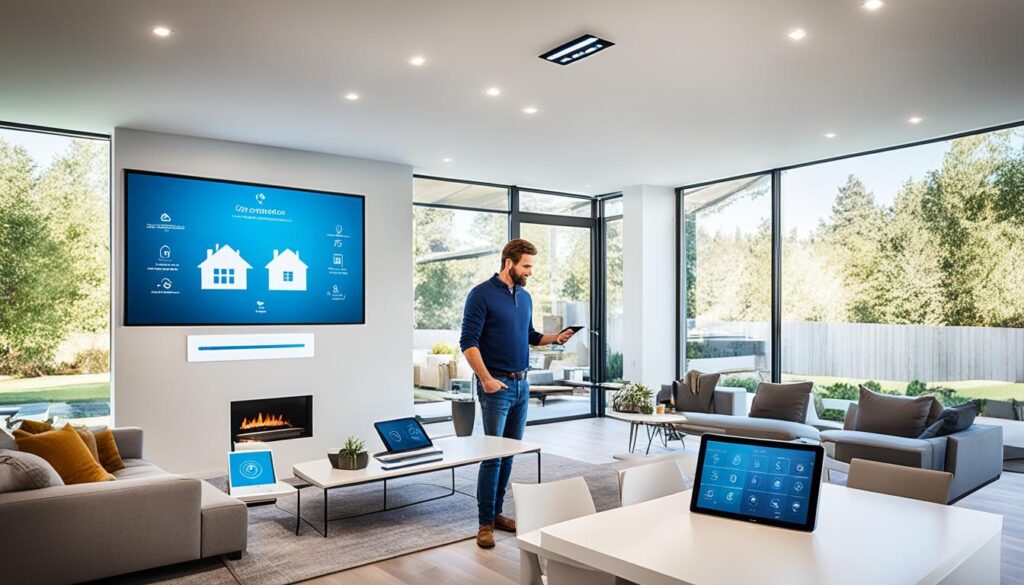
Selecting Smart Home Devices
Starting your journey with smart home devices means choosing wisely. Smart home devices, home automation systems, and voice-controlled smart home gadgets make your house interconnected. This leads to more convenience and intelligent home tech. Here are some important things to think about when picking the right smart devices for you.
Voice-Controlled Smart Home Devices
Voice control has changed how we use smart home devices. Now, you can easily control many gadgets with just your voice. Voice-controlled smart home devices work with Amazon Alexa, Google Assistant, or Apple HomeKit. With these, you can control lights, adjust the temperature, play music, and more using just your voice.5 Make sure the smart devices you choose work with the voice assistant you like best. This ensures everything works together smoothly.
Connected Home Solutions
Connected home solutions bring all your smart gadgets together. You might have a central hub or smart speaker that controls it all. This hub takes care of everything from security cameras and lights to thermostats and appliances.56 Picking a good connected home system means you get easy automation, better security, and save energy in your home.
When picking smart home devices, keep compatibility, setup ease, and how well they work with your current home tech in mind.156 Doing your homework and investing in the best smart home tech can turn your house into a intelligent home tech paradise. This will make your life easier and your home more comfortable.
| Smart Home Device | Average Installation Cost |
|---|---|
| Lighting Control System | $500 – $5,0001 |
| HVAC Control System | $2,000 – $10,0001 |
| Security and Surveillance System | $1,000 – $5,000+1 |
| Entertainment System | $1,000 – $10,000+1 |
| Smart Appliances | $100 – $500 per appliance1 |
Planning the Installation Process
To start a successful smart home automation installation, careful planning is vital. It’s key to choose the right spots for your home automation devices. This ensures they work well and cover your whole automated home.1 Make sure to place sensors, cameras, and other devices in smart locations. This way, your system works better and looks good too.
Mapping Out Device Locations
When laying out your smart home integration, think about each room’s size and light. Also, watch out for things that could block your devices’ signals.2 Put motion sensors in busy spots to catch movement correctly. Also, where you put intelligent home tech like cameras and smart speakers matters. They’ll work better and fit in well with your whole system.1
Ensuring Compatibility
It’s also crucial to check that the systems you select work together.2 This means making sure that all your devices can talk to each other. Before buying, do your homework on what each device needs to work. This step helps you avoid problems and makes the setup go smoothly.1
Spending time on figuring out where to place devices and checking compatibility pays off. It makes your smart home automation installation work seamlessly. Then, you can enjoy the best in convenience, control, and efficiency at home.
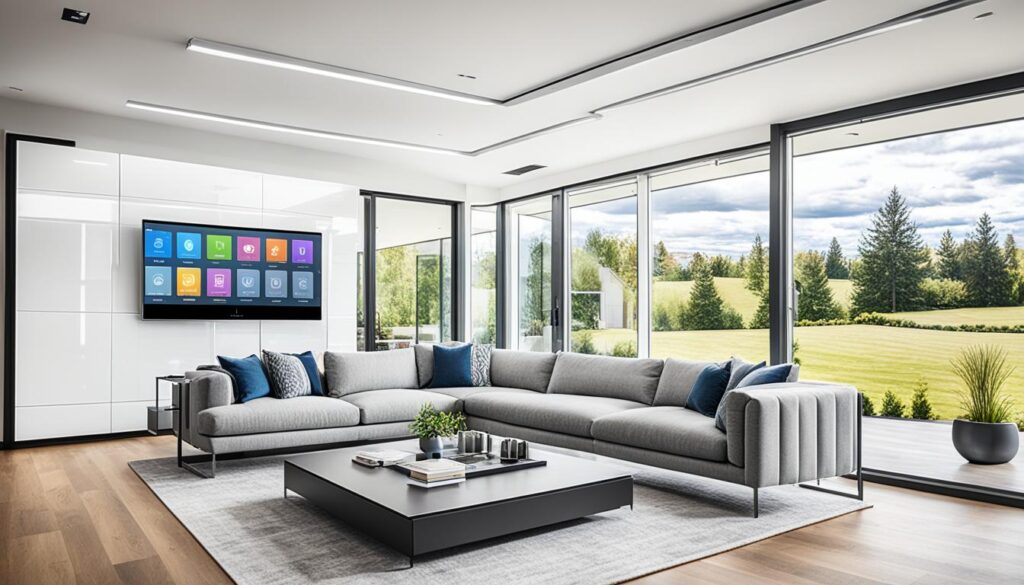
smart home automation installation
Step-by-Step Installation Guide
Setting up your smart home system needs careful planning. This ensures it all works smoothly. You’ll go through five main steps: Preinstallation, Installation, Post-installation, Integrating with VMware Aria Automation, and Installing Salt.2
In the beginning, you’ll figure out what you need and pick suitable systems. Think about how much automation you want. Also, consider what smart devices you’ll use and how much you can spend.1
The next step is installation. You’ll establish the foundation with key parts like an API server and databases. For extra stability, multiple servers and databases might be needed.2
After the setup, it’s time to get everything working together. Ensure devices talk to each other. You might have to sync voice assistants, lights, HVAC systems, and more for a unified experience.2
Integrating Devices with Your Automation System
Linking your devices is key for a well-operating smart home. This includes connecting lights, thermostats, cameras, and more to a central point.2
Devices use various wireless tech to connect, like Wi-Fi. It’s important to set them up right for a solid network. This keeps everything running smoothly.6
You can control everything with your phone, by voice, or using control panels. Just how much you can tweak things depends on the system and devices you have.2
Making sure your devices can work together takes careful planning. Talk to experts or check out in-depth guides for a trouble-free setup.6
Configuring Smart Home Automation
Starting your smart home automation adventure? Setting up custom rules is key. This makes your system work just the way you want.1 The price can vary a lot. From $100 to $3,000 for DIY options. Or $100 to $300 for pro help with DIY.1 Fancy systems from brands like Elan, Savant, and Crestron might cover the setup cost.1 Setting up lights control might cost you $500 to $5,000. It depends on the lights you have and how complex the wiring is.1 For heating and cooling control, be ready to spend $2,000 to $10,000. The price changes with your home’s size and the system’s features.
Setting Up Customized Automation Rules
Smart home tech lets you make rules that suit your life perfectly. You can do things like turning lights on at certain times or adjusting the temperature when you’re not home.5 There are three main types of smart home systems: Google Home, Amazon Alexa, and Apple HomeKit. They each have special things.5 Alexa works with the most devices. And HomeKit is known for being very safe.
Optimizing Your Smart Home Experience
To make the most of your smart home, think about where you put devices, how they connect, and if they work well together.2 In the US, more than 50 million homes use video surveillance. Wired HVAC systems are becoming popular too. They let you control the temperature from your phone.2 Smart lights add a cool vibe to your place. They might change color or turn on when they sense movement.2 And now, smart appliances are joining the club. Fridges that let you see inside from afar and even order food are making life easier.
Smart home tech can really tailor your living space to you. It enhances how cozy, convenient, and safe your home feels. With the right tech, your smart home will be an easy part of your daily life.
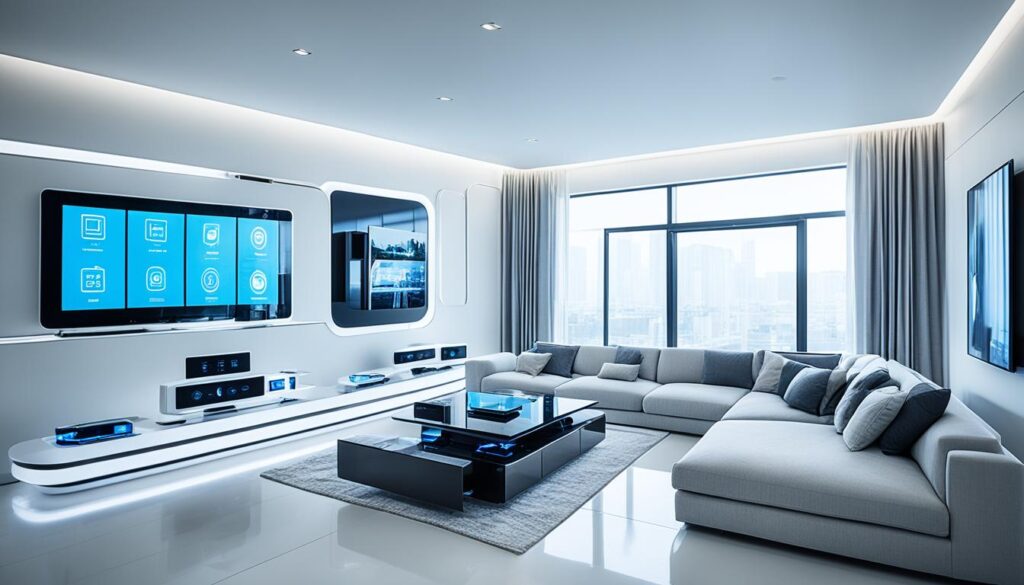
Troubleshooting Common Issues
More and more people are making their homes smart. But as they do, they often face problems. These can range from not being able to connect their devices to making sure everything works well together.7 It’s key to solve these problems for a smooth smart home experience. Let’s look at some common issues and how to fix them.
Connectivity Problems
One big issue is smart devices not syncing up.7 Most of these devices come with their own mobile apps. But folks like to control everything using just one app or system.7 Devices may also struggle to stay connected to the internet. In this case, getting a better Wi-Fi router can help.7 Also, it’s important to keep similar devices close enough to communicate well.7
If you’re having trouble with connections, check your Wi-Fi first. Moving the device closer to the router can make it run better.8 If that doesn’t work, it might be time for a new router. Old routers might not handle multiple smart devices too well.9
Device Compatibility Concerns
Getting all your devices to work with each other can be tricky.8 There are various smart gadgets out there, like lights, thermostats, and cameras. Each has its own needs.8 Make sure they’re all on the same page, network-wise, and have the latest updates.8
Sometimes, smart gadgets don’t listen to commands.8 To fix this, make sure they’re turned on and part of the network. Don’t forget to check for updates.8 If nothing works, a reset or calling the maker for help may be needed.8
To avoid future headaches, a smart hub can be very useful.9 This device can link all your tech together. Oh, and always keep your gadgets and router up to date.9
Maximizing Security and Privacy
More and more people are getting smart home automation installation and home automation systems. This makes it crucial to keep our intelligent home tech safe and private. With lots of automated home control and voice-controlled smart home gadgets, we must work hard to keep our network safe. We also need to protect our personal information.10
Securing Your Smart Home Network
Your smart home network’s safety is super important. To keep your connected home solutions safe, use strong security methods. These could include end-to-end encryption and two-factor authentication.10 It is also smart to update your device’s software often. This keeps them safe from new risks.
Protecting Personal Data
Smart home devices gather a lot of personal info. It’s key to protect this data well. Check the privacy rules of your smart home devices closely. Make sure info like what you like, your voice recordings, and your activity logs is kept safe.10 Choose smart home gadgets that care about user privacy. These might offer end-to-end encryption and a secure way to store data. This helps keep your personal info private.
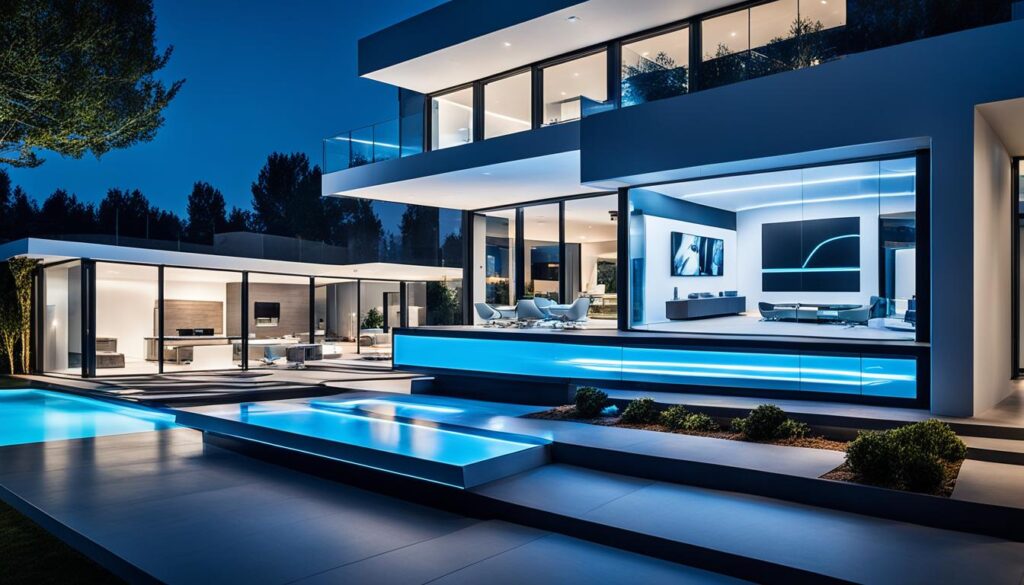
By focusing on security and privacy, we can enjoy the benefits of smart home automation installation. This way, we also keep our home automation systems safe and protect our personal info.10 Keep up with the latest in smart home security. Also, look into new tech that can keep your intelligent home tech safe. This brings peace of mind and security to your home.
Smart Home Installation Services
Implementing a top-notch smart home system needs expert help. Professional services can ensure your tech runs smoothly. They optimize for the best performance.11
Versed Automation is a top player with over 8,000 supported devices.11 They are experts in installing Crestron systems. Clients love their integration work, especially with URC products.11
If you want your smart home to work well with Apple products, choose Savant. It lets users easily enjoy Apple’s tech.11 Versed Automation shines with unbeatable client ratings. They’ve proven this with complex installations, like setting up 13 CCTV cameras for a client.11
Versed Automation’s clients are very happy, especially with Lutron lights and Starlink internet.11 Providers like Geeks on Site, with 20 years’ experience, can handle your smart home needs with care. They offer services across the nation.12
Want to upgrade your home’s convenience, energy savings, or safety? The right smart home service is key.12 Geeks on Site is here 24/7 and backs their work with a 7-day warranty. They make sure your connected home works perfectly.12
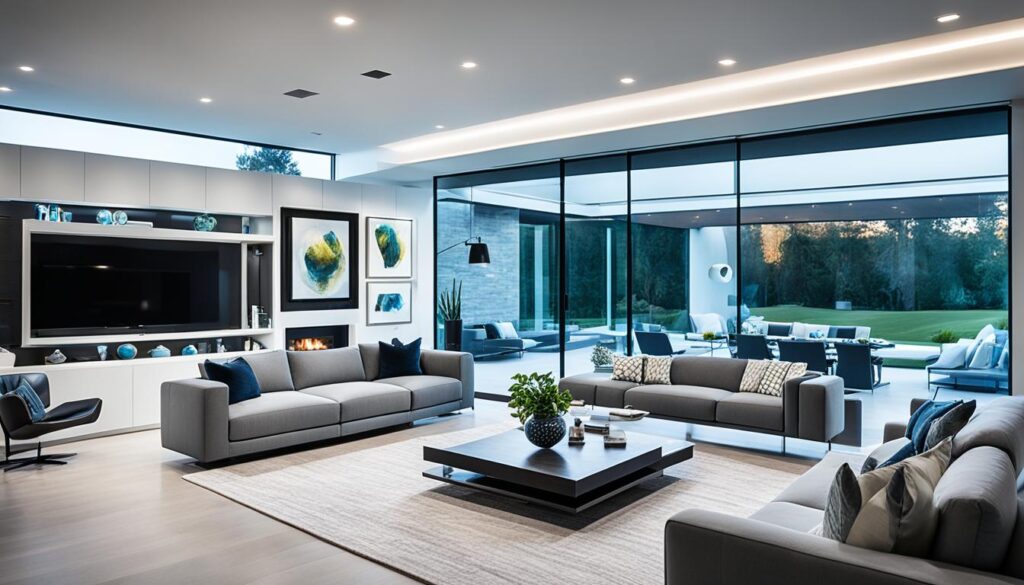
Maintaining and Upgrading Your System
If you’re a smart homeowner, it’s key to keep your system updated and fresh.13 This means regularly updating software and adding new gadgets. Doing this helps your home tech work better and keeps you up to date with the newest features.
Regular Software Updates
It’s vital to keep your smart home software current.14 Companies often send updates to fix problems, add new stuff, and work better with other tech. Always update your system as these updates arrive. This ensures everything runs smoothly and welcomes new tech easily.
Adding New Devices and Features
With the smart home market growing, you might want to add more devices for a better experience.15 You could get a smarter thermostat, security cameras, or lighting. These additions can make life easier, save energy, and lower your bills over time.
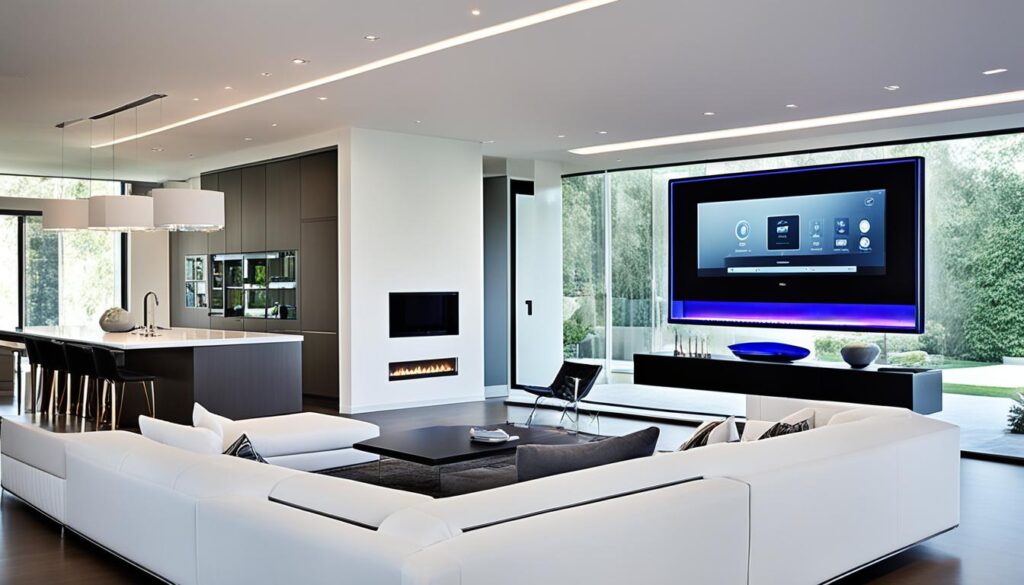
Keeping your home tech up to date is a great move. It makes your place more efficient, handy, and innovative. With regular updates and new devices, your smart home will shine, working perfectly and delighting you every day.
Future Trends in Home Automation
Technology is moving fast, and smart home automation is in for big changes. New smart home technologies will give us new ways to manage our homes. We’ll enjoy more convenience, save on energy, and feel safer.16
Emerging Smart Home Technologies
The world of smart homes keeps growing. There are now gadgets for every need, like voice control and all-in-one systems. The future will be full of smart tools that make life easier for everyone.16
The Internet of Things (IoT) Revolution
The Internet of Things (IoT) is at the core of this change. It brings all devices together in a smart home. This lets homeowners do everything from far away, like managing energy and keeping the home secure.16
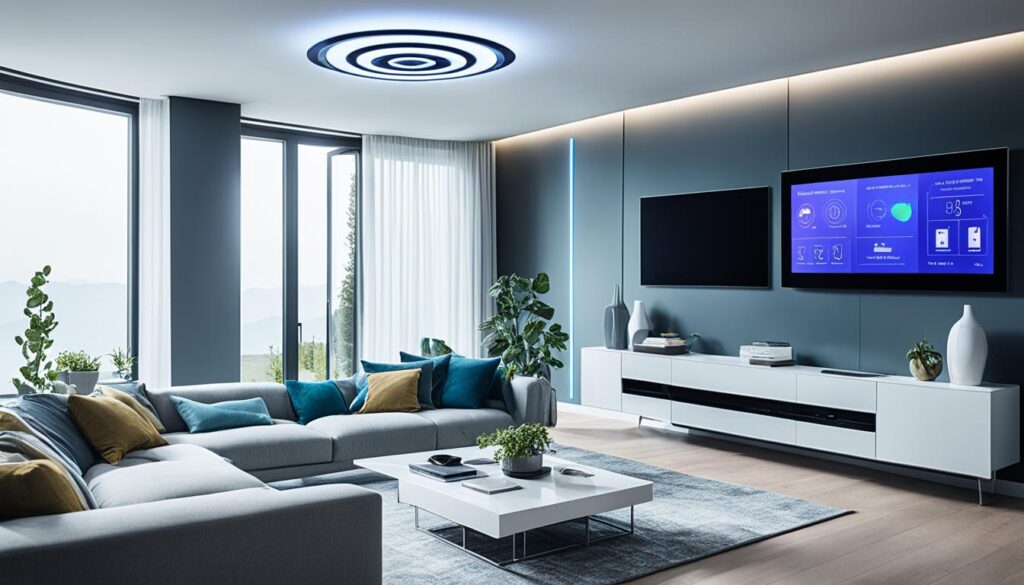
Things are getting more exciting in the home automation world. We’ll see new tech like voice control and data-driven systems. More people are using smart home solutions, leading to big changes and lots of new ideas.16
Conclusion
Smart home automation has changed our lives in remarkable ways. It blends technology seamlessly into our daily experiences. Now, we can set up video surveillance2, control our home’s temperature from afar2, and adjust lighting and entertainment with a simple command2.
To make the most of these smart features, it’s all about planning wisely and choosing the right gadgets. This means looking at what you really need, selecting the best automation tools, and finding devices that work together. Doing this lets you craft a home that knows and meets your specific preferences and routines. For example, check out Home security cameras by AlfredCamera. They offer neat functions like talking through your camera and spotting people with special software2.
The trend toward connecting everything in our homes, known as the Internet of Things (IoT), will only grow. Soon, appliances will order our groceries and assistants will understand our voice commands. In this future, our homes will just get smarter, improving not just our comfort but life in general. To make this bright future a reality, all we need to do is keep learning and welcome these new technologies into our lives.
FAQ
What is Automation Config and how does it work?
Automation Config is a modern tool that makes managing your system easier. It helps do common jobs in system administration automatically. It makes sure all parts of your system work exactly as you want. This tool uses four main parts: Automation Config API server, Salt master(s), PostgreSQL database, and Redis database. Together, they control the whole life of your machines.
What are the benefits of using Automation Config?
Automation Config works well with many existing technologies. This means you can keep using what you know. It can understand different signals and data from other tools to make sure your computers work perfectly. Plus, it helps keep your whole system running smoothly.
How do I install Automation Config?
Installing Automation Config involves several steps. First, prepare your system, then install the tool. After that, make sure everything is set up right. You’ll also need to match it with VMware Aria Automation for some tasks. Don’t forget to add Salt to the machines you want to control. For the best setup, you might need more than one of each main part if you want to avoid any system crashing.
How does Automation Config integrate with VMware Aria Automation?
By working with VMware Aria Automation, you can easily put Automation Config on your machines. You can use cloud templates from Aria Automation or put the service there with Secure Shell. This link lets you oversee your whole system in one place.
How do I scale and manage Automation Config deployments?
You can make Automation Config bigger and keep it running well. Normally, you put each main part on a different computer. This means you use four computers when you’re done. If you’re worried about your system stopping, you might need more parts. This keeps your system from going down and makes sure it stays working.
What types of infrastructure tasks can Automation Config automate?
There are many things Automation Config can do. It can handle tasks like making sure the right people can get into your system, checking if everything is working right, and updating parts when needed. This makes everything run smoothly and cuts down on work you have to do by hand.
How does Automation Config handle third-party tool integration?
Automation Config is very flexible. It can understand what other tools are saying to take the right action. You don’t have to redo everything to use this tool. It can work with what you already have and make it better.
Source Links
- https://reolink.com/blog/home-automation-installation/
- https://alfred.camera/blog/home-automation-installation/
- https://www.hgtv.com/design/remodel/mechanical-systems/home-automation-design-and-installation
- https://audiotecdesigns.com/home-automation-system-setup-guide/
- https://www.wired.com/story/how-to-set-up-smart-home/
- https://brittsmartsecurity.com/blog/smart-home-automation-installation
- https://www.nachi.org/problems-smart-home-tech.htm
- https://www.linkedin.com/pulse/how-troubleshoot-common-issues-smart-home-fjmfe
- https://www.asurion.com/connect/tech-tips/5-most-frequent-problems-with-smart-home-tech/
- https://reads.alibaba.com/maximizing-efficiency-and-security-a-comprehensive-guide-to-smart-home-improvement/
- https://www.versedautomation.com/smart-home-installation/
- https://geeksonsite.com/smart-home/
- https://handymanconnection.com/mckinney/articles/exploring-smart-home-upgrades/
- https://garrettsystems.net/blog/when-should-i-upgrade-my-smart-home-system
- https://hubitat.com/blogs/home-automation-blog/introduction-to-home-automation-upgrades
- https://www.thefarnsworthgroup.com/blog/smart-home-automation-trends
